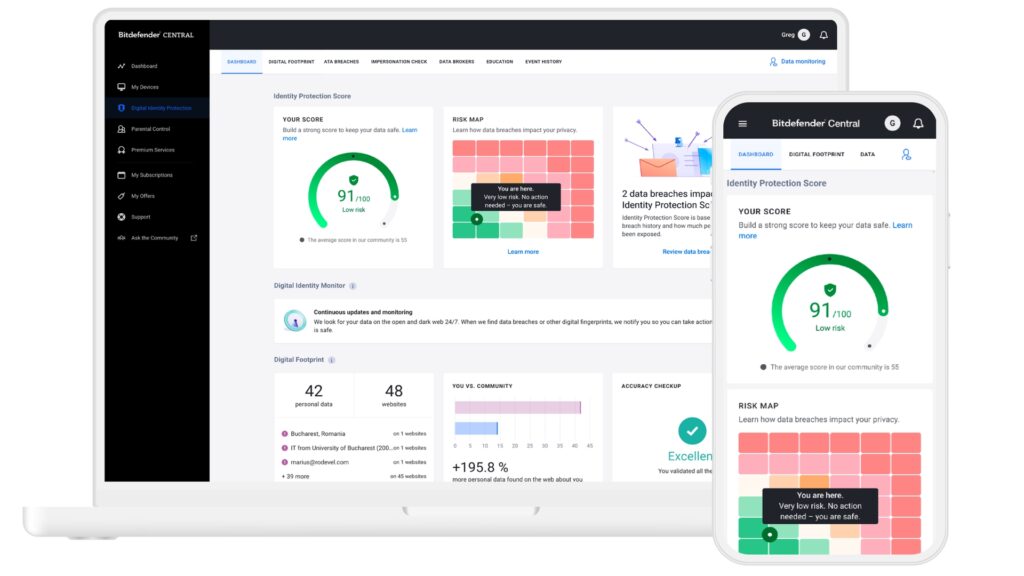Phishing, malware or a well-crafted scam, hackers are not lacking in inspiration to collect your data and use it. By taking a few precautions, the risk of identity theft can be greatly reduced. Here they are.
Identity theft has accelerated in France in recent years, especially since the Covid-19 pandemic and the transition to all-digital by most French companies and administrations. A veritable boulevard has opened up for hackers, who claim nearly 200,000 victims each year.
It is by collecting as much personal data as possible that they are able to usurp identities. The final objective being the subscription to credits for the benefit of the hackers, but in the name of the victims. Although it is impossible to protect yourself completely against identity theft, here are some best practices to limit the risks. In addition, solutions like Bitdefender Digital Identity Protection allow you to identify any data leaks.
Phishing: the entry point for many hackers
To impersonate a person, the kidnappers need some strategic information. The name, contact details (postal, telephone, bank) and a copy of the identity document are the main ones. Phishing (or phishing) is therefore the royal way to obtain them without the victim noticing.
Gone are the days of error-filled emails. Hackers surf on current news and trends to prepare highly credible messages. They transmit them on various channels, ranging from traditional email to SMS and instant messaging on social networks.
Each of these messages generally contains a link to the mirror website of a bank, the Post Office, Pôle Emploi or any other institutional site. Once connected to the page in question, the Internet user is asked to send a series of confidential information and sensitive documents such as a copy of an identity document, bank details, tax notice or proof of residence.
These elements alone are sufficient, for example, to subscribe to an online consumer credit. Hence the importance of:
- pay attention to the sender of the message and the email address or account used (official bodies never send emails with a Gmail address, for example);
- enter the URL of the site concerned yourself rather than clicking on a link sent by message;
- favor messaging integrated into your customer space to communicate sensitive data and send supporting documents to an organization;
- keep in mind that no bank or government department will ask you for sensitive documents and information by email or SMS. This is usually done from personal accounts.
Beware of offers that are too good to be true
On the internet, caution is required. As far as possible, for non-commercial and non-institutional sites, it is better to avoid communicating your real name, contact details and date of birth. Therefore prefer a pseudonym to protect your anonymity.
As usurpers increasingly resort to scams and false advertising online, check the consistency of a commercial offer before compiling a file and transmitting sensitive information. Credit rates or real estate rental prices that are far too attractive should immediately alert you. Similarly, an organization that asks you for far too many documents in relation to your request should raise doubts. In any case, make sure that you are on the official site of the company concerned and above all that the URL is well secured via the “https” protocol.
On social networks, same fight. You need to be extra vigilant. Surrounded by family and friends, you may be tempted to share too much information, whether on your newsfeed or via private messages. But, between the risks of having your account hacked and fake profiles, it is essential never to publish a photo of your identity papers or sensitive documents.
Secure your accounts and devices
While some kidnappers use phishing to collect personal data, others favor more discreet and insidious methods like hacking into your devices and accounts. Fortunately, some good practices can limit the risks.

Protecting your online accounts with strong and unique passwords is one of them. But, don’t worry, your memory won’t be put to the test. Password managers take care of generating them for you, storing them securely in encrypted form and delivering them to you when you need them. To go further, it is recommended to opt for two-factor authentication whenever a site offers it.
Once the security of your accounts is reinforced, it’s time to protect your devices. First of all, block access to it with a password or an unlock code. Then, equip all your electronic devices (smartphone, tablet, PC) with a complete protection solution and ban any connection to public Wi-Fi networks, unless you have a VPN. Also encrypt all data stored on external media, so that your data remains inaccessible to others, even in the event of loss or theft.
Finally, install security updates for the operating system, software, and applications, as soon as they are offered to you.
And since zero risk does not exist, even taking all possible precautions, it is important to regularly check your bank account statements. In the slightest doubt, quickly contact your bank adviser to obtain more details on an operation and possibly prepare a complaint. Reacting quickly is essential, because the law imposes certain deadlines for notifying the bank in the event of fraud and requesting the reimbursement of the funds.
Bitdefender: a turnkey solution to protect yourself
It is difficult for an Internet user to know if he has been the subject of a violation of his personal data. Some hackers take a long time to act and empty the bank account of their victims. That’s why Bitdefender Digital Identity Protection continuously scans the web as well as the dark web, and alerts you when your data is compromised.

Bitdefender Digital Identity Protection thus allows you to have a complete view of your digital footprint and know exactly which site has information about you. Even personal accounts that you may have created voluntarily in the past are listed there.
But, this tool does not only inform you of the location of your data or a possible leak. It also takes care of removing them from the dark web and any location that you have not authorized, in order to give you complete control of all your personal information. Bitdefender Digital Identity Protection then provides you with a whole series of recommendations to prevent such a data breach from happening again.
In addition, you don’t need to be a computer expert to access all its features. Not only is Bitdefender Digital Identity Protection ready to use and requires no installation, but the solution is also easy to use. At a glance, you know if your data is safe and in a few clicks, you fix any problems.
Do you want to have better control of your personal data? Right now, Bitdefender Digital Identity Protection is only 35.88 euros, or 2.99 euros per month, the first year, instead of 69.99 euros.
